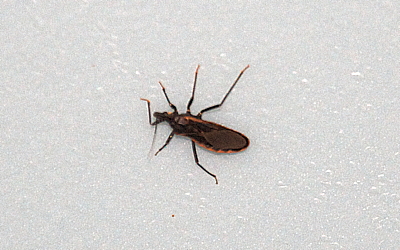
Mercury, Jupiter's Galilean Moons, Lunar Crater Stöfler,
Mars, Saturn, Kissing Bugs
Posted: 5 June 2014
|
Opened: Wednesday, 5 June 2014, 1740 MST Temperature: 113°F |
Session: 691 Conditions: Partly cloudy, breezy |
Opened the observatory early to prepare for a transit of the moon by the Chinese space station Tiangong-1, which would occur well before sunset.
1757 MST: checked focus using Sirius, then slewed to Mercury. Its thin crescent was difficult to initially locate against the bright blue sky about 90 minutes before sunset using 83X. Mercury was really difficult to see using 222X.
1800 MST: viewed the moon, 222X and 83X, then began preparing for the Tiangong-1 moon transit. Mounted the D7000 DSLR at the 8" prime focus + 2X PowerMate. Did some test exposures and a test HD video recording. 1814 MST: ready for the transit. The sky was mostly clear now. I did an HD video recording, 1/1600sec, ISO 5000, from 1817 MST to 1819 MST in order to (hopefully) capture the transit at 18h34m18s MST. Conditions were not ideal due to the sky brightness and upon reviewing the video no space station was located.
1845 MST: back to Mercury. It took a couple of minutes to locate it in the eyepiece at 83X due to the sky brightness. But once I found it, the thin crescent looked really nice. Began setting for iPhone 5s imaging even though seeing was not very good. This is a stack of 523 slo-mo video frames (5 seconds, 120 fps) at 666X:

1915 MST: Mercury now too low for viewing. Slewed to Jupiter. At 1917 MST, could barely detect two moons (Ganymede and probably Io) using 83X. Using 222X I could see that what I thought was one moon was actually two: Io and Europa. 1931 MST: sunset. Callisto was now visible at 222X. This handheld iPhone 5s afocal 222X photo (cropped) shows the four moons:

1938 MST: visited the moon. Using 222X, seeing was not great but there were some nice sights visible. This D7000 DSLR photo was taken at prime focus, 1943 MST, 1/250sec, ISO 400:

There was a nice shadow visible in the Crater Stöfler in the southern terminator. This prime focus + 2X PowerMate, "Hat Trick", ISO 100, shows the southern terminator with Crater Stöfler at the center:

This highly magnified view, cropped from a handheld iPhone 5s afocal 444X photo, shows the shadows in Crater Stöfler:

2002 MST: saw two Kissing Bugs on the dome, the first of several this night:

Then saw a third one; all three were terminated. (For those new to my Reports, I don't like Kissing Bugs. They are about an inch long and are blood suckers. They will suck for up to 15 minutes and can be a source of a serious disease.)
2009 MST: did a quick tour of the lunar terminator, 222X, then slewed to Mars. Saw the 4th Kissing Bug; terminated.
2015 MST: viewed Mars, 222X. Seeing was not very steady, but the North Polar Cap, Syrtis Major, and south polar clouds were visible. Set up for iPhone 5s imaging. This is a stack of 3523 slo-mo video frames (30 seconds worth), 666X + one Variable Polarizing Filter:

Saw two more Kissing bugs, but they were too high on the dome to reach.
Slewed to Saturn. Seeing was not good. This is a stack of 3527 slo-mo video frames, 666X:

(The Moiré pattern visible on the planet's disk is due to the extreme image editing I had to do.)
Then terminated the 5th and 6th Kissing Bugs. Saw a 7th one on the dome, which was terminated a few minutes later.
2037 MST: viewed Saturn, 222X. Seeing lousy but did see four moons: Titan, Rhea, Dione, and Tethys. The four moons were easily seen at 83X.
2043 MST: ended observing and did some software beta testing for a few minutes.
I then began closing up as I had to do some night photography for the Oracle State Park "International Dark Sky Park" proposal. As I was leaving the observatory saw the 8th Kissing Bug; terminated.
|
Closed: Wednesday, 5 June 2014, 2100 MST Temperature: 79°F |
|
In "International Dark Sky Park" news, I was interviewed by Arizona Public Media for a radio show broadcast on Tuesday, 3 June 2014. You can listen to the audio file of their report.
Also, in support of Oracle State Park "Going for the Gold", the local Ford dealership manager has agreed to disable six lights at his location that are unshielded. Many thanks to him for that!
Comments are welcome using Email. If you are on Twitter you can use the button below to tweet this report to your followers. Thanks.
Cassiopeia Observatory Home Page